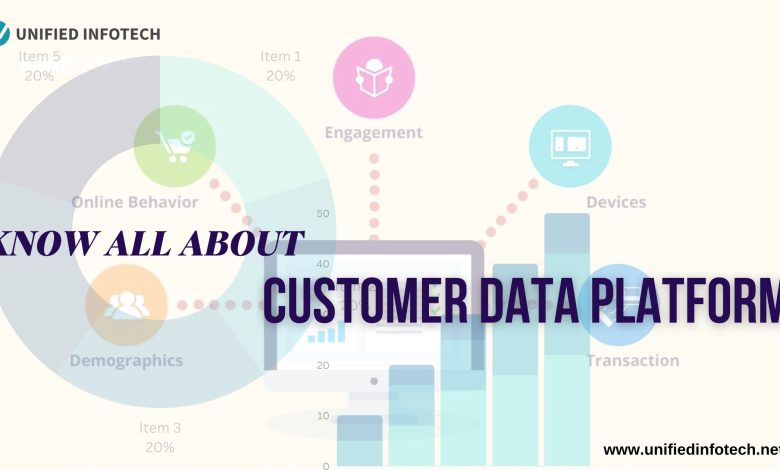The Complete Guide to Customer Data Platform (CDP)

What is a Customer Data Platform?
A customer data platform (with an acronym CDP) is a packaged software. It combines first-party customer data from several sources to create a single, comprehensive view of each customer profile. CDPs aggregate data from sources like web forms, emails, transactional systems, social media activities, DMPs, CRMs, and more. The customer database can be accessed by other systems to track, manage, and analyze all touchpoints and interactions.
The activities made on a website, via an app, or through other channels like live chat or digital assistants, as well as the frequency and length of those encounters, constitute behavioral data.
Transactional data from POS or e-commerce systems, such as customer purchases and returns, involve demographic information, including the customer’s name, month, and year of birth and address.
Examples of top Customer Data Platforms include – Bloomreach Engagement, Segment, Blueshift, Totango, Listrak, and Insider.
Why is Customer Data so Important?
Customers anticipate truly individualized service after having it once. No matter the channel, you must offer the same—or better—level of customer service to maintain your business reputation. It is typically exceedingly challenging for businesses to offer consistent customer experiences across a variety of channels and consumer devices because customer data is typically held in silos, whether organizational or technological. A customer data platform (CDP) makes it possible to have current, well-maintained, and accessible customer data.
Why do You Need Customer Data Platforms?
There are numerous factors that make a CDP crucial. A platform for client data has three uses.
Combine all first-party data
Many of the systems used by marketers operate in silos and don’t communicate data back and forth, including email, analytics, CRM, e-commerce, and social media platforms. Getting a clear picture and understanding what you’re seeing are difficult tasks. A customer data platform connects all the marketing technologies used by marketers and serves as a single source of truth for first-party consumer data in order to solve these problems.
Manage customer data
By managing consent and the data flows across various marketing systems, CDPs manage first-party data, data rights, and customer privacy. In the era of data protection, your company must actively manage consent and data flows and document this management.
Activate third-party data
You can act on first-party user data after receiving consent to gather it, after unifying and organizing it into profiles. Utilizing audience segments throughout the rest of your marketing platforms and channels is a capability of CDPs.
What are the Features of a Customer Data Platform?
Even though the CDP functionality varies across vendors, the main features are:
- Identity Resolution: CDPs create unified consumer profiles based on the concept of digital identities. Although different CDPs may employ different approaches to combining the several “versions” of a prospect or customer, the end result is always the same: the creation of a single customer view.
- Real-Time Segmentation: Dynamic segments can be made and saved using CDPs. You may construct lists on almost any attribute or event, thanks to CDPs’ connections to all of your tools and data sources, allowing you to target your audiences with a high degree of specificity.
- Data Ingestion: CDPs often consume data from online and offline sources such as web tracking tools, marketing automation, CRMs, and data warehouses, using APIs.
- Data Processing: The operational data layer for an organization is intended to be a CDP. The user interface of a CDP can be used to execute data processing operations like transforming, cleaning, and enriching data, or code can be used instead.
- Data Syndication & Synchronization: By establishing boundaries between what is synced and what is not, CDPs provide you complete control over data flows. If you have complete control over your data flows, you can avoid “overcrowding” your destination tools. In some situations, reduce the need for API calls and data storage.
Who are the Users of Customer Data Platforms?
Although a CDP will ultimately benefit go-to-market teams, including sales, demand generation, and others, we have found that the following roles frequently initiate and oversee it after implementation:
- Marketing activities
- Sales activities
- Growth marketing
- Growth operations
- Data Engineering
- Data operations
Are there any differences between CDP and DMP?
A CDP is mainly used for marketing operations. It aggregates first-party consumer data from different sources to build a coherent view of each of the clients. It makes these data available to marketers for targeting and personalizing marketing campaigns.
In order to enable web display adverts, a data management platform (DMP) was created for the purpose of advertising. A DMP collects information from cookies for campaigns intended to attract new clients. The data gathered by DMPs is frequently anonymized and retained for a brief amount of time, typically 90 days, in contrast to the data collected and aggregated by CDPs.
What is the difference between CDP and CRM?
The key difference between a CDP and a CRM is that a CDP gathers data on customer behavior within your product or service and makes it simpler to connect that data to additional third-party systems. A CRM solution, on the other hand, organizes and handles customer-facing interactions with your staff.
Conclusion
In this post, we have discussed how CDPs are beneficial in enhancing customer experience (CX). It combines all data types (structured, unstructured, online, and offline) for a centralized view. It also combines data from all customer touchpoints, including email, social media, loyalty programs, and in-store transactions, with data already present in other internal systems, like DMP, ERP, CRM, and others, to generate a continuously updated 360-degree perspective of the consumer.
Different departments can collaborate when they have the same view of the consumer since they can identify who is interacting with a customer or if there is no interaction at all. Businesses may communicate consistently and engage customers in a seamless manner by using CDPs. A CDP enables a company to accurately target specific customers, tailor their experience, and forge enduring connections that increase retention rates.





